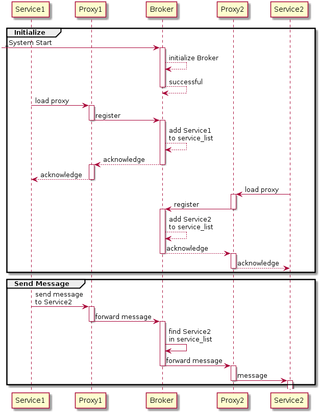The Jakarta Messaging API is a Java application programming interface (API) for message-oriented middleware. It provides generic messaging models, able to handle the producer–consumer problem, that can be used to facilitate the sending and receiving of messages between software systems. Jakarta Messaging is a part of Jakarta EE and was originally defined by a specification developed at Sun Microsystems before being guided by the Java Community Process.

In computer science, inter-process communication (IPC), also spelled interprocess communication, are the mechanisms provided by an operating system for processes to manage shared data. Typically, applications can use IPC, categorized as clients and servers, where the client requests data and the server responds to client requests. Many applications are both clients and servers, as commonly seen in distributed computing.
In computer science, message queues and mailboxes are software-engineering components typically used for inter-process communication (IPC), or for inter-thread communication within the same process. They use a queue for messaging – the passing of control or of content. Group communication systems provide similar kinds of functionality.
Message-oriented middleware (MOM) is software or hardware infrastructure supporting sending and receiving messages between distributed systems. Message-oriented middleware is in contrast to streaming-oriented middleware where data is communicated as a sequence of bytes with no explicit message boundaries. Note that streaming protocols are almost always built above protocols using discrete messages such as frames (Ethernet), datagrams (UDP), packets (IP), cells (ATM), et al.
IBM MQ is a family of message-oriented middleware products that IBM launched in December 1993. It was originally called MQSeries, and was renamed WebSphere MQ in 2002 to join the suite of WebSphere products. In April 2014, it was renamed IBM MQ. The products that are included in the MQ family are IBM MQ, IBM MQ Advanced, IBM MQ Appliance, IBM MQ for z/OS, and IBM MQ on IBM Cloud. IBM MQ also has containerised deployment options.
Tuxedo is a middleware platform used to manage distributed transaction processing in distributed computing environments. Tuxedo is a transaction processing system or transaction-oriented middleware, or enterprise application server for a variety of systems and programming languages. Developed by AT&T in the 1980s, it became a software product of Oracle Corporation in 2008 when they acquired BEA Systems. Tuxedo is now part of the Oracle Fusion Middleware.
Stratus VOS is a proprietary operating system running on Stratus Technologies fault-tolerant computer systems. VOS is available on Stratus's ftServer and Continuum platforms. VOS customers use it to support high-volume transaction processing applications which require continuous availability. VOS is notable for being one of the few operating systems which run on fully lockstepped hardware.
The Advanced Message Queuing Protocol (AMQP) is an open standard application layer protocol for message-oriented middleware. The defining features of AMQP are message orientation, queuing, routing, reliability and security.

A message broker is an intermediary computer program module that translates a message from the formal messaging protocol of the sender to the formal messaging protocol of the receiver. Message brokers are elements in telecommunication or computer networks where software applications communicate by exchanging formally-defined messages. Message brokers are a building block of message-oriented middleware (MOM) but are typically not a replacement for traditional middleware like MOM and remote procedure call (RPC).
MessagePlus/Open is a communication platform for medium to large organizations designed specifically to handle high volumes of traffic within a high-availability environment. Currently supported communication channels include fax, fax over IP, e-mail and SMS, together withvarious options for integration with business applications. The product has been developed by INTERCOPE GmbH, Germany and is sold by both Intercope and IBM. It was previously known as FaxPlus/Open.
Component Object Model (COM) is a binary-interface technology for software components from Microsoft that enables using objects in a language-neutral way between different programming languages, programming contexts, processes and machines.
Open Message Queue is an open-source message-oriented middleware project by Oracle that implements the Java Message Service 2.0 API (JMS). It is the default JMS provider integrated into GlassFish.
A message queueing service is a message-oriented middleware or MOM deployed in a compute cloud using software as a service model. Service subscribers access queues and or topics to exchange data using point-to-point or publish and subscribe patterns.

OS 2200 supports all commonly used, and many not so commonly used, distributed processing protocols, APIs, and development technology.
The Application Interface Specification (AIS) is a collection of open specifications that define the application programming interfaces (APIs) for high-availability application computer software. It is developed and published by the Service Availability Forum and made freely available. Besides reducing the complexity of high-availability applications and shortening development time, the specifications intended to ease the portability of applications between different middleware implementations and to admit third party developers to a field that was highly proprietary in the past.
ZeroMQ is an asynchronous messaging library, aimed at use in distributed or concurrent applications. It provides a message queue, but unlike message-oriented middleware, a ZeroMQ system can run without a dedicated message broker; the zero in the name is for zero broker. The library's API is designed to resemble Berkeley sockets.
Middleware is a type of computer software program that provides services to software applications beyond those available from the operating system. It can be described as "software glue".
Apache Kafka is a distributed event store and stream-processing platform. It is an open-source system developed by the Apache Software Foundation written in Java and Scala. The project aims to provide a unified, high-throughput, low-latency platform for handling real-time data feeds. Kafka can connect to external systems via Kafka Connect, and provides the Kafka Streams libraries for stream processing applications. Kafka uses a binary TCP-based protocol that is optimized for efficiency and relies on a "message set" abstraction that naturally groups messages together to reduce the overhead of the network roundtrip. This "leads to larger network packets, larger sequential disk operations, contiguous memory blocks [...] which allows Kafka to turn a bursty stream of random message writes into linear writes."


